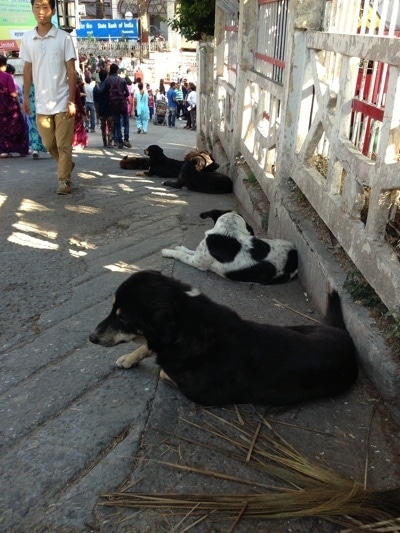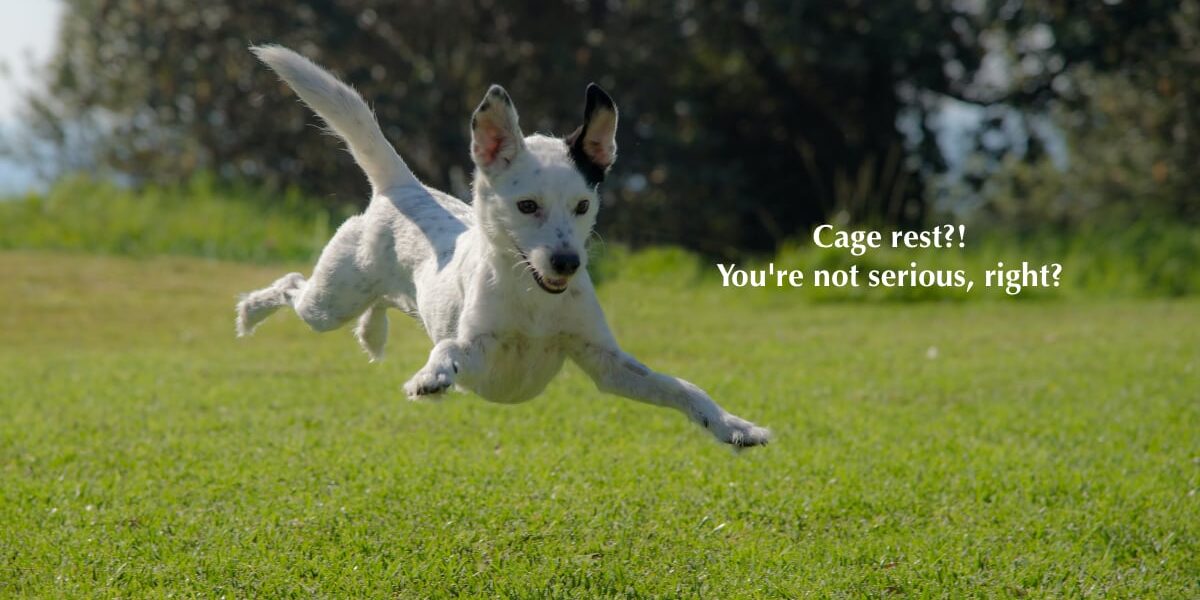A World Apart: The Street Dogs of India
 Yesterday, in the middle of a busy marketplace in Mussoorie, India, two dogs stood rear end to rear end, locked in a genital tie up in the middle of the street. Unless you’ve seen it, you may not know that the male dog’s penis becomes so engorged near the end of copulation that, once ejaculation occurs, it forms a seal against the vaginal walls, preventing separation for some time. Think awkward, helpless minutes of post coital bliss.
Yesterday, in the middle of a busy marketplace in Mussoorie, India, two dogs stood rear end to rear end, locked in a genital tie up in the middle of the street. Unless you’ve seen it, you may not know that the male dog’s penis becomes so engorged near the end of copulation that, once ejaculation occurs, it forms a seal against the vaginal walls, preventing separation for some time. Think awkward, helpless minutes of post coital bliss.
Shoppers walked past the pair unfazed, intent on seeking their desired goods. The dogs seemed as unperturbed as the shoppers, though they looked so vulnerable to me.
The values of different cultures can help inform our own, and travel helps one take one’s boundaries less seriously. There are very few pet dogs in India, most wandering the streets, foraging, sleeping out of the way of traffic, and guarding their territory against dogs who don’t belong. The dogs I saw looked quite fit and vital, making do as opportunist feeders in a world where they are simply accepted as part of God’s creation. Likely, they were untouched by the vaccinations that are bringing so much illness to our domestic canines.
Speaking With Authority
The language of the street dogs of India is like that of another culture as well.
I watched from my friend’s van as a black male street dog approached a yellow male dog who was obviously a visitor, and an unwelcome one at that. The yellow intruder stood firm, and growled a low guttural growl as the black guard advanced, hackles raised, teeth bared, a more menacing and louder tone issuing forth in his warning growl.
What could have been an explosive fight with blood shed was avoided with careful diplomatic skills. The yellow dog, equal in size to the advancing guard, stood erect, ears forward, hackles raised, tail up, but allowed the more menacing black dog to sniff his anus. Once sniffed, without showing the slightest sign of weakness, the yellow visitor moved off in a measured, confident gait. He was clearly deferring to the black dog’s authority, and taking a slightly submissive role, but in no way inviting an attack, launching one of his own, or showing fear or weakness. After passing the wheel of a parked van a bit up the street, he glanced back to see that the guard was not advancing on him, and kept walking calmly away. Violence averted.
A Battle Over Sexual Rights
In another incident, a female in heat ended up provoking a violent fight. She was being mounted unsuccessfully by a male suitor. After several failed attempts, a second, more determined male who been an onlooker mounted and tried repeatedly to gain entrance to her vagina. His efforts finally brought pain to the female, who turned to bite his foreleg to get him to stop. Her cries of pain were like a siren heard by her pack, who suddenly materialized out of nowhere, and a fracas ensued. Apparently the determined suitor was either not of this pack or was a very lowly member, as he was roundly attacked by several males, one in particular who took the lead with ferocious intensity. The attacked male found himself bitten at from all sides, the din of the street fight grew, until finally the underdog was on his back encircled by his attackers. With darting, lightening like lunges, the alpha male unleashed vigorous bites to the underdog’s genitals until the poor dog finally squealed and hobbled off, alone. The group then dispersed, back to the business of being street dogs in man’s world.
One can imagine the genetic implications of such pack behavior. The alpha male’s genes would predominate in this pack, perhaps promoting more vigorous pups suited to survival in the streets of India.
Street Dog Features
Remarkably, street dogs in India all look strikingly similar. They have medium length coats, are mostly black with a few yellow or spotted variants, weigh about 50-60 pounds, have slightly flopped ears and long muzzles. They remind me of German Shepherd mixes without the long coat.
A much earlier trip through Europe and No. Africa in my college days saw street dogs that more closely resembled Pit Bull mixes. I suspect canine appearance varies quite widely depending on locale.
Cancer Spread by Touch?
Another Indian street dog had a likely venereal tumor on the underside of his tail. Canine Transmissible Venereal Tumor is an infectious form of cancer that is found world wide. Imagine: cancer spreading by physical touch, cells from the tumor setting up a new tumor in the dog who came in contact with the “infected” dog. It turns out only two species are known to have cancer that spreads this way: the dog and the Tasmanian devil.
Cancer researcher Elizabeth Murchison has sampled these tumors and found virtually the same genome in them as that which appeared in dogs from 11,000 years back. The tumor appears to have jumped to multiple continents about 500 years ago. How fascinating that this tumor has propagated throughout the world and remained virtually unchanged from continent to continent over such vast stretches of time.
Starch Digestion
It appears from other research that dogs are more able to digest starch than their near ancestors, the wolves. But that certainly doesn’t mean they’ll thrive on it. People have learned the hard way that starches and sugars have been responsible for myriad diseases in our species, from obesity and diabetes to heart disease. I’d not wish those on the dog or cat, the carnivores who walk among us. Feeding kibble has resulted in more of these diseases than those who eat balanced raw diets.
In the end, while cultural differences abound, from dogs being eaten in the Philippines and China to being revered as close family members in the West, to living by their wits on the streets of India, dogs are very much the wolves of our domestic world, their behaviors shaped by circumstance and need.
Have you come across domestic animals living quite differently than those we are used to in the first world? Tell us about it in the comments.




What an adventure Doc! You really have the gift of writting. 🙂
Thanks Stacey. Glad it struck a chord for you.
I have to comment again since I consider my country, one of the ones from the third world especially a the present time. But the situation in there it is not as Margaret describe Cuzco’s dogs. You see the dogs that live in the streets with not owners at all, maybe some people will let their dogs go out and then they come back home. Those dogs do not expend all day out.
Also Dr. Falconer there are a lot of dog lovers in my country. A lot of dogs live a life similar to the dogs here. I came from a family of animals lovers, and have some extended family that brought several dogs from the street to be adopted as their pet treating them as children until they passed away. A lot of dogs and cats there do not co-exist with man’s world they live with their people.
Another variation on a theme from another part of the world. Thanks Ester. Sounds a bit like the Indian cows, who wander during the day, but come home at night to be milked, fed, and offered a resting spot before heading out to forage the next morning.
Street dogs of Cuzco, Peru…I observed a similar circumstance in Cuzco, Peru a few years ago, while on vacation with my husband. There were lots of dogs in the street, lots!, but no-one bothered with them or gave them any attention. They had a routine and an order to their roamings. Early one morning, I noticed one little dog waiting on a street corner, waiting for what??? For his friends to join him, and they did, coming to him from different directions, he waited until they had all gathered around him and then, they all crossed the road together and headed off to the street market to check out what goodies might be thrown their way by the vendors getting their food stuffs ready for the day. These dogs traversed the very crazy and unpredictable traffic of Cuzco, with the greatest of ease and confidence. Never did I see a dog get hit by a car! To me, this was amazing, my dogs are not car savy at all. I finally realized, by rising very early one morning that a lot of these dogs actually had humans that they lived with, but were let out early in the morning to go about the day on their own and then return at night to guard the homes of their humans. It all worked so well, the dogs were healthy and they did not beg or bother people in the street and; of course, they knew where to go back to each evening. ( I’ve always had a hard time understanding how a dog can get lost in it’s own neighborhood, as happens so often here). Dogs, left to their own devices figure out a system of survival and maneuvering and read cues from each other. I never saw a single dog fight in Peru. I think we, in modern, western society have forgotten how to live along side our canine companions; opting instead, for complete control of them. After seeing how dogs live in South America and Mexico, I’m not convinced that our way is better.
Thanks for that perspective, Margaret. Certainly thought provoking, isn’t it?
The dogs I saw there were certainly not in bad straits from what I could see, so I suspect there was a fair amount of selection at work: the strong, most adapted to street life thrived, while the weaker ones died off. That’s how nature works, but that would be unacceptable to a large proportion of Westerners.
We in the West are far more attached to this species, much as we are to our own children. In India and most of the third world, they coexist in man’s world, largely on their own but fairly dependent on man’s scraps and waste to survive.
My friend and her husband had a very similar experience in Costa Rica about 4 months ago. They also were there on vacation. They’ve rescued and foster several dogs and remarked to me that the street dogs there looked so much healthier than the shelter dogs we see here in the US. I have no doubt that every creature is better off without vaccines and commercial pet foods. Nothing good comes from toxins, poisons and cells of other species being eaten or injected into the body.
All our pets have suffered vaccine damage. My family has decided that our next pack will come from a natural rearing breeder. God bless these wonderful people who are doing all they can to restore health to their chosen breeds.
We love your newsletter, Dr. Falconer and read every word of it. We also share it with family and friends who love animals.
It’s remarkable, isn’t it Dede? You’d imagine just the opposite would be the case: the dogs, left to their own wits to get food and wandering the streets would have to be less healthy than those receiving medical care and diets designed by scientists, wouldn’t you?
Unless you look deeper at what “medical care” means, and what’s in the average kibble. Then it all makes perfect sense.
Thanks for sharing your friend’s story and for sharing Vital Animal News! Glad you’re on the Natural Path with us!
Wow!! indeed. You really captivate your readers with your writing! It is fascinating to read the story. Being from South America I have come across domestic animal living in packs in the streets. They eat from garbage cans and scraps they get from people. But I have been away for such a long time, that I cannot comment specifics at the present time. Also, they do not get vaccinated like the ones in India. Thank you for sharing your trip with all of us.
Amazing story to hear from your travels. Thanks for sharing your observations through the written word. The picture you attached to this story of the street dogs of India was striking as the dog in the for front looked very similar to my dog, Lady. She too, was rescued from the street life but here in the US. We rescued her along with her 7 pups finding homes for her pups but ultimately keeping her because she chose us. She is different than our other dogs of the past. She is a loving dog but affection must be her idea. She has never lost her independence and still treasures some form of freedom. When we take daily walks on the leash, towards the end of our walk, I can tell she longs to run free off leash. When safely close to home, I unleash her. She runs for home as if to say to me that I cannot keep up with her. She turns her head to check that I am running along behind. She always wins and seems contented by her accomplishing that feat of reaching the door first. Aww, still has the heart of a street dog. Love reading your stories and sharing life’s path.
Hi Jackie,
Lady sounds like one lucky dog. I love the run home, “beat you, Mom!” part. Something I used to do with my dogs when ever possible: we’d leash up till we got to some more wild part of the walk, and then I’d unleash, have him sit attentively awaiting my command, and, on “OK!” he’d rush off to explore the wild world of smells and interesting things.
Thanks for sharing that with us.
Absolutely fascinating! I felt as if I were on the trip with you. The dog species always intrigues me and I must say more so now. These dogs that are street bound did you ever see anyone interact with them, how do they get fed???
Very little interaction with them, Bonny. It’s a culture that probably has more fear of them than love, like we do. Most just ignore them and some may give food, but largely they are opportunists, and are seen in dumpsters, etc looking for scraps.
Wow! That was fascinating!!!
You are an excellent writer, and reading from the viewpoint of a Veterinary doctor made for a unique perspective you can’t find anywhere else! Thank you!!
I am so grateful to you. You are one of the few medical practitioners who works in harmony with nature and does not assume a position of superiority to natural process.Your blog inspires me and gives me hope that our species can begin to work in harmony with nature as opposed to attempting to control it. A rare few in the medical community are beginning to acknowledge how little we know about how to work in cooperation with natural systems. The evidence of this is that we now understand that we can’t just eradicate bacteria with a slash and burn mentality because we destroy the natural balance in the body and create drug resistant monster bacterial strains. Thank you for sharing so freely the knowledge that is important for me to have as well as your experience of the beauty of our planet. My animals thank you too.
Thanks for your kind words, Darlene.
I just took a look at your report on Oscar, and I really have to smile when I read,
That’s a sure sign that chronic disease has been significantly diminished. Less a “brake on his wheel.”
It sounds like the last remedy back in March was truly homeopathic to his condition and he’s largely righted himself: less thirst, normal amount of urine, and more energy to engage in play, even at his age. Our plan?
Watch & wait, until he says “I need help again” by making symptoms on a regular basis. Might be months or a year, up to Oscar.
Thanks again. I hope you’re well.